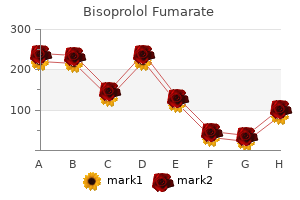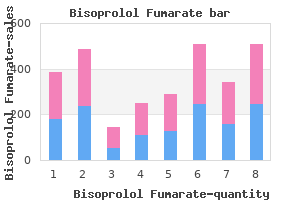"Discount bisoprolol generic, juvenile blood pressure chart".
By: R. Trompok, M.B. B.CH., M.B.B.Ch., Ph.D.
Vice Chair, University of California, Davis School of Medicine
Proven bisoprolol 10 mg
Basically, there is no confirmative laboratory test for the hypermobility type, meaning that it is a pure clinical diagnosis. Also, a changing phenotype from one diagnosis into the other in one individual and in some pedigrees 26 the occurrence of both diagnoses argued for this statement. Larsen syndrome, which also features congenital luxations, should be in the differential diagnosis. It is one of the rarest of all types and since only very few cases have been described, possibly this type is characterised by other as yet unrecognised features. The mode of inheritance is autosomal recessive (see glossary), whereby both parents of a patient are healthy carriers and the recurrence risk for siblings is 25% (=? Laboratory tests should start with measurement of the urinary lysyl and hydroxy-lysyl pyridinoline ratio. The mode of inheritance is autosomal recessive (see glossary), whereby both parents of a patient are healthy carriers and the recurrence risk for siblings is 25% (=? Because of severe hypotonia, patients very often undergo a full scale neuromuscular work-up, including a muscle biopsy before the diagnosis is established. The differential diagnosis comprises all other causes of severe hypotonia, including neonatal Marfan syndrome. Minimal diagnostic criteria are thin cornea with or without rupture plus either at least one other major criterion and/or 3 minor criteria (see table 2-5). The urinary lysysl and hydroxylysyl pyridinoline ratio is moderately increased (to approximately 1 compared to normal values of ~ 0. Minimal diagnostic criteria are congenital muscle hypotonia and/or muscle atrophy that improves with age plus either one other major criterion and/or three minor criteria. Among these, one finds not surprisingly other heritable connective tissue disorders like cutis laxa, osteogenesis imperfecta, Stickler syndrome (see chapter 5), Loeys-Dietz syndrome and Marfan syndrome, but also skeletal dysplasias, inborn errors of metabolism, neuromuscular disorders, chromosomal abnormalities and syndromes like Larsen syndrome, Fragile X syndrome and Langer-Giedion syndrome. Like always in clinical practice, the results of history taking, including a family history, and physical examination are the basis for planning additional investigations and finally reaching a diagnosis. This is already standard routine diagnostic practice in some laboratories and will become routine in all in the near future (see chapter 3). Good history taking starts with identifying the exact symptoms and complaints, which compelled the patient to see a physician: when and how did they start and evolve, how were they treated (what were the results, what was advised/prescribed and by whom? Specific questions should elucidate the presence or absence of: Hypermobility and/or (sub)luxations. If (sub)luxation occurred: which joint(s) was/were involved, how often did it occur, was it spontaneous (also the first time) and painful? If so: which ones, when, under which circumstances, exercise related, warm and swollen, if so, for how long?
Syndromes
- Gastric suction
- Gagging
- Joint swelling in the affected area
- High blood pressure
- Abnormal production of pancreatic enzymes
- Cancer
- Nausea
- Liver cancer (hepatocellular carcinoma)
- Diabetic neuropathy

Discount bisoprolol generic
Statins Statins should be prescribed to patients who have had an ischaemic stroke, irrespective of cholesterol level. Avoid atenolol in adults over 60 years of age, unless they have coronary artery disease. If convulsions are not controlled within 10 minutes administer an additional 10mg per hour Cardiac Diseases in pregnancy a. Ischemic heart disease Chest pain characterized as a crushing pain radiating to the left arm. Hypertension in Athletes Hypertension is a common cardiovascular condition a ecting athletes. However, the management of hyper tension in athletes can di er from standard approaches, primarily due to the potential side e ects of some medications that may impair training and performance. The most challenging group is elderly athletes who often attribute their exertional dyspnea or fatigue to ageing. Have these highlights do not include all the information needed to use personnel and resuscitative equipment immediately available (5. Approval: 2008 heart disease, pericarditis or pericardial effusions, stenotic carotid artery disease with cerebrovascular insufficiency, or hypovolemia (5. Some seizures are administered as an intravenous injection within 10 seconds; followed prolonged and require urgent anticonvulsive management. Adhere to the recommended duration of injection [see Dosage and Administration (2)]. As noted in an animal study, longer injection times may increase the duration and magnitude of increase in coronary blood flow [see Clinical Pharmacology (12. In clinical trials, hypersensitivity reactions were reported in fewer than 1 percent of patients [see Adverse Reactions (6. The risk of serious hypotension may be higher in patients with autonomic dysfunction, hypovolemia, left main coronary artery stenosis, stenotic valvular heart disease, pericarditis or pericardial effusions, or stenotic carotid artery disease with cerebrovascular insufficiency. In post-marketing experience, syncope, transient ischemic attacks and seizures have been observed [see Adverse Reactions (6. Most increases resolved within 10 to 15 minutes, but in some cases, increases were observed at 45 minutes following administration [see Clinical Pharmacology (12. The population was 26?93 years of age (median 66 years), 70% male and primarily Caucasian (76% Caucasian, 7% African American, 9% Hispanic, 5% Asian). Most adverse reactions began soon after dosing, and generally resolved within approximately 15 minutes, except for headache which resolved in most patients within 30 minutes. Most respiratory adverse reactions resolved without therapy; a few patients received aminophylline or a short-acting bronchodilator. Pre-specified respiratory adverse reactions included dyspnea, wheezing, obstructive airway disorder, dyspnea exertional, and tachypnea. The most common adverse reactions are similar in type and incidence to those in Table 1 above for both Groups. Table 4 shows a comparison of cardiac events of interest for the two groups [see Warnings and Precautions (5.

Discount bisoprolol 5mg with mastercard
Although quantitative coronary angiography after stress testing, as a prerequisite for subsequent provides a more accurate assessment of lesion severity revascularization. Manystenoses Study of Comparative Health Effectiveness With Medical considered to be severe by visual assessment of coronary and Invasive Approaches) trial is currently randomizing angiograms. Coronary angiography also cannot revascularization (when appropriate) plus optimal medi assess whether an atherosclerotic plaque is stable or caltherapy. The writing group has found that creating a disease), severe valvular disease, severe comorbid medi recommendation governing the use of angiography for calconditions. The writing bleeding disorders, or a history of an allergic reaction to group recognizes, however, that many clinicians believe radiographic contrast material (28?32). Theriskof thatpromptdiagnosticangiographyandrevascularization, contrast-induced nephropathy is increased in patients instead of initial stress testing, are appropriate for such with renal insuf? Theconcept Coronary angiography is not routinely performed after of informed consent requires that risks and bene? Therefore, when clinicians strongly suspect that a tions, coronary angiography is useful to a) ascertain the stress test is falsely negative. The f) assess the suitability for revascularization of patients optimal rate of normal coronary angiography in clinical with unacceptable ischemic symptoms. Advocates maintain that this process eterization had normal coronary arteries (de? Among See Table 2 for the revised recommendation for chelation patients with diabetes mellitus, there was a 39% reduc therapy and Online Data Supplement 2 for evidence sup tion (hazard ratio: 0. Food and counterpulsation or to inactive counterpulsation (with Drug Administration for speci? Over the 7-week study period, average wrapped around the lower extremities to increase venous Canadian Cardiovascular Society angina class improved return and augment diastolic blood pressure (47). Other putative mechanisms for improvement in however, a high degree of heterogeneity among the symptoms include recruitment of collaterals, attenuation studies, which lessens con? A treatment improved perfusion images and increased exercise dura course typically consists of 35 sessions of 1 hour each, tion. Contraindications include decom improvement of $1 Canadian Cardiovascular Society pensated heart failure, severe peripheral artery disease, angina class in 81% of patients immediately after the last and severe aortic regurgitation. The present section echoes patients with diabetes mellitus and complex multivessel those management recommendations. The Heart Team is a multidisciplinary team tions in this guideline consistently among groups. Finding What Works in Echocardiography, American Society of Nuclear Cardi 106?13. Cardiovascular Computed Tomography, Society for Patterns in visual interpretation of coronary arterio 3. Committee on Cardiovascular Magnetic Resonance, and Society of grams as detected by quantitative coronary arteriog Standards for Developing Trustworthy Clinical Practice Thoracic Surgeons. Circulation 2013;127: tion in contemporary practice: the Assessing Angiog ischemic heart disease: a report of the American Col 2177?85.

Order bisoprolol 5mg with visa
All therapeutic decisions regarding thrombosis prophylaxis were based on the department protocol not the Caprini score. The department protocol divided patients into low or high risk based on the presence or absence of one or more of the follow ing criteria. Total hip and knee replacement patients who were considered low risk received aspirin 325mg twice daily for six weeks. At the conclusion of the study a retrospective chart review of every patient was conducted and a Caprini score determined for each of these individuals. Statistical analysis indicated that the high-risk cutoff for the Caprini score was 10 or above. Eight patients in this study suffered a symptomatic venous thromboembolic event and ac cording to the department protocol, 7 of these individuals were considered low risk receiving only aspirin prophylaxis. On the other hand, seven of the eight patients with the thrombotic event were correctly placed in the high-risk group with a Caprini score of 10 or more. Once the results of this study became available, the department protocol was abandoned in the Caprini score is now used prospectively to classify these total joint replacement patients and provide appropriate prophylaxis. Medical patients A number of studies have addressed the Caprini score in medical patients over the past few years. Several impor tant factors are recorded in the Caprini score that are missing in the Padua score and other more recent scores proposed for use in medical patients. The most important missing factor in these other scores is family history of thrombosis. Obstetrical complications are another important missing question not addressed in other scores. These obstetrical complications may be associated with the Antiphospholipid Antibody Syndrome which may be associated with an increased risk for thrombosis. Another simple fact is no other risk scores look at as many variables, and we know the more thorough a history and physical, the more comprehensive analysis of risk is possi ble. Unfortunately life is not simple and just looking at some common risk factors often results in missing important variables. A number of large hospitals have suggested that using a hospital-wide risk assessment tool is preferred for a num ber of practical reasons. Thrombosis It is important to understand that skilled surgeons are rightfully concerned about postopera tive bleeding that may result from prophylactic anticoagulants. Kakkar and associates published a randomized prospective multicenter trial involving pro phylaxis against fatal pulmonary emboli using low-dose unfractionated heparin. Anticoagulant prophylaxis was used for one week, and objective endpoints including venography were employed.
Proven bisoprolol 10 mg. Reversing Type 2 diabetes starts with ignoring the guidelines | Sarah Hallberg | TEDxPurdueU.

